Intel Core 2 Extreme X6800 Preview from Taiwan
by Anand Lal Shimpi & Gary Key on June 6, 2006 7:35 PM EST- Posted in
- CPUs
Gaming Performance
Next up was gaming performance, and of course using our own game demos. We tested everything at 1024 x 768 since we only had a single 7900 GTX per system at our disposal.
We already knew to expect solid Quake 4 performance out of Intel's Core architecture, and the Core 2 Extreme X6800 does not fail us - offering just under 24% better performance than the FX-62.
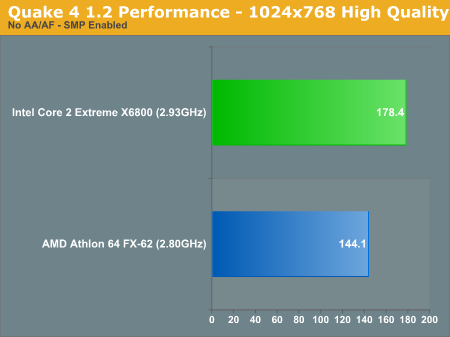
We've also already seen Conroe's performance under F.E.A.R., and with the latest 1.05 patch performance is in line with our expectations:
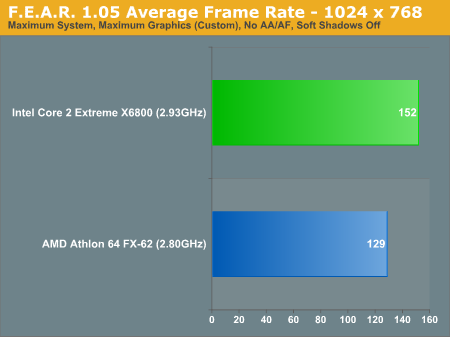
Core 2 Extreme boasts a 17.8% performance advantage over the FX-62 in average frame rate.
The minimum frame rate is significantly higher at 50.9%, and even after multiple runs the performance advantage was consistent:
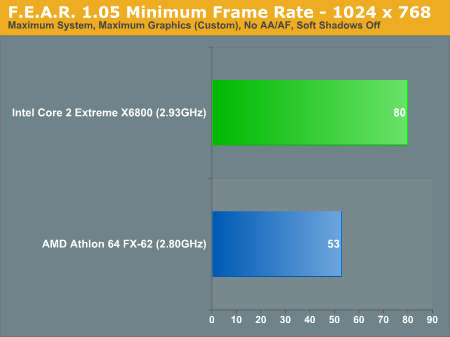
Finally the Core 2 Extreme system was able to boast a 14.2% higher maximum frame rate under F.E.A.R.
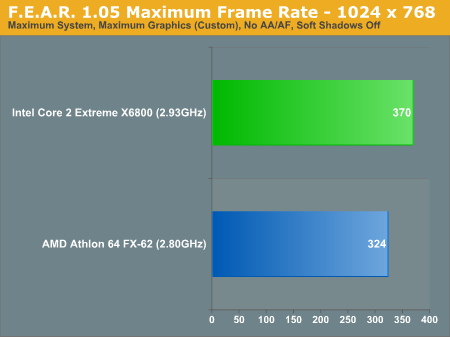
Our final gaming benchmark during our short but sweet testing period with the Core 2 Extreme was Battlefield 2, and its performance was in line with what we've seen in the previous two titles:
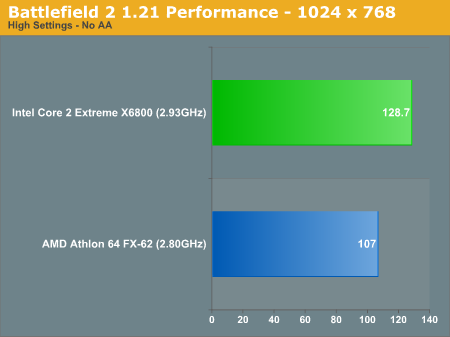
Intel's holding on to a 20.3% performance advantage under Battlefield 2.
We're still wary of crowning Intel the new gaming performance champion, especially without having run other very important titles such as Oblivion and Half Life 2: Episode 1, but until we can things are definitely looking extremely promising for the Core architecture.










134 Comments
View All Comments
Boushh - Wednesday, June 7, 2006 - link
The difference seems to be the HD PC Stats is using a Raport, Anand a Hitachi) instead of the memory (alltough it will have some impact, maybe even the SLi setup will have some impact).If you look at the communication test (which, according to Anand, is very I/O bound) you'll see:
Anand:
FX-62: 178
Core 2: 184
PC Stats:
FX-62: 263
D940 - 189
That is a huge difference. That will sureley translate into the overall scores, and it will influence some of the other scores.
So what was your point again ?
zsdersw - Wednesday, June 7, 2006 - link
More tests will be coming out.. don't get your undies in a bunch.JumpingJack - Thursday, December 8, 2016 - link
what an idiot.VooDooAddict - Wednesday, June 7, 2006 - link
The tests they have shown definetly have value to them. They are the tests that could be done in the time provided to show some nice direct comparisons between the very near future "top end" CPUs.To all those complainging about 1024x768:
Once they have the CPUs back in the labs I'm sure they will give us some highend video benchmarks as well. While the CPU doesn't have the largest impact at extreme resolutions I'm sure everyone can agree that it does have an impact, expecially with software driver overhead. However we should be more concerned with testing the CPUs on SLI/CrossFire. Other benchmarks have shown that the CPU can be a real limiting factor in high res SLI tests due to the large overhead from the SLI/CrossFire drivers. These CPUs are in the price bracket of those looking at SLI and even QUAD SLI systems (I can hardly begin to imagine the CPU overhead from QUAD SLI).
Personally I don't mind the 1024x768 ... then again that's probably because I run a large 27" 1280x720 pannel for gaming.
Genx87 - Wednesday, June 7, 2006 - link
I was shocked to see the chip being used was 2.93Ghz. I was expecting it to be the 2.67Ghz chip Intel showed off.However this doesnt take away from the chip itself, it is still a very fast chip and I see an E6600 in my future.
However if you get time I am curious what kind of performance differences the AMD platform see's between this new Nvidia chipset and the chipset used by Intel. To me it appears to be at least a single speed grade if not more. The %'s appear on the surface to be the same as Intels demo but the difference is you are stuck using a higher speed grade to get this performance difference.
VooDooAddict - Wednesday, June 7, 2006 - link
Nice grab AT editors! I knew someone would find a way to get out hard info before the NDA, glad it was AT.With this knoledge I'm budgeting the E6600s (2.40GHz/4M) for my next SFF build. And I'm content waiting just a little longer.
Only thing that will disapoint me with the new build will be the lack of any true DX10 video options. However, thanks to what you've shown us, it looks like the first gen DX10 will be too power hungry for a SFF machine. Looks like I'll have to manage with a single 7900GTX or 7950GX2.
drewintheav - Wednesday, June 7, 2006 - link
What will the real retail prices for conroe be? I would not be surprised if the initial retail prices are double what is being quoted everywhere!fikimiki - Wednesday, June 7, 2006 - link
Why didn't you take 4-4-4-12 memory which should give AMD much more speed thanks to smaller latency?This benchmarks only proves that IDF preview when 2.8 Athlon vs. 2.66 Conroe was benchmarked was setup by Intel - most of the benchmarks show 20% difference, not 30-40%.
Conroe is 4.5% faster clock-for-clock than AMD.
Taking an AVERAGE not RARE AND LOW DDR2 memory from the market and lowering clock to 2.8 should prove that Conroe is maybe faster clock-for-clock. And I belive that author knows that, but no conclusion about that.
DigitalFreak - Wednesday, June 7, 2006 - link
Oh, my, god! Did you not read the article? That's the memory they had available.Anand has been doing this for a VERY long time, and has proven time and time again that he is unbiased.
On the other hand, WHO are you?
fikimiki - Wednesday, June 7, 2006 - link
Who am I? Just a computer user who understands all the fuss Intel is spreading from last 3 months. It is all about "controlled benchmarks" who proves nothing except a wish to beat competitition. If you look around to see other benchmarks you can see that Athlon performance is slight different.Look here http://www.pcstats.com/articleview.cfm?articleid=1...">http://www.pcstats.com/articleview.cfm?articleid=1... and you will see that Athlon was able to get 261 instead of 210 in Anand test.
Conroe gets 266. So this is 266 (2.93GHz vs 261 2.8GHz? You see the difference?